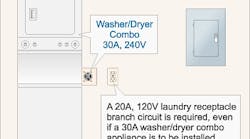Q. We recently bid a project that involved a stackable washer/dryer in each dwelling unit of an apartment building supplied by a single 30A, 240V receptacle circuit. The inspector says we must install a 20A, 120V laundry receptacle circuit in addition to the 30A, 240V receptacle circuit. This makes no sense to me.
A. The Code doesn't provide for an exemption to the rule in 210.11(C)(2) and 210.52(F) that requires a receptacle outlet served by a 20A branch circuit to be provided in the laundry area of a dwelling unit. This circuit would be in addition to the 30A branch circuit required for the combination washer/dryer (Figure).
Q. My understanding of Art. 645 is that for a room containing data processing equipment to be classified as an information technology equipment (ITE) room, all of the provisions of 645.2 must be complied with. This means that if a disconnecting means isn't provided to disconnect power to all electronic equipment and HVAC systems serving the computer room, then the room isn't an ITE room and none of the requirements of Art. 645 must be complied with. So the way I read it, a disconnect for the electronic equipment and HVAC system is an option for a computer room. Am I correct?
A. Yes. If a disconnecting means isn't installed for the electronic and HVAC equipment in accordance with 645.10, then the electrical installation is neither required nor permitted to be installed in accordance with the requirements of Art. 645. Art. 645 relaxes some of the installation requirements that one would typically expect in Chapter 3, but only if the room is classified as an ITE room. For the room to be classified as an ITE room, all of the following must be met:
-
A disconnecting means that complies with 645.10 is provided.
-
A dedicated HVAC system is provided for ITE and is separated from other areas of the occupancy.
-
Only listed ITE is in the room.
-
Only those persons needed for the maintenance and operation of the ITE should occupy the room.
-
The room is separated from other occupancies by fire-resistant walls, floors, and ceilings, with protected openings.
Note: An ITE room is an enclosed area specifically designed to comply with the construction and fire protection provisions of NFPA 75 - Standard for the Protection of Electronic Computer/Data-Processing Equipment.
Q. Can 480V branch-circuit conductors be installed in the same raceway with 120V branch-circuit conductors?
A. Yes, as long as all circuit conductors have an insulation voltage rating not less than the 480V circuit voltage. Since THHN/THWN building wiring is rated 600V, this isn't a problem.
Q. Our emergency generator serves a 3,000A main lug distribution board (eight sets of 500 kcmil). Are the conductors from the generator to the distribution board considered service or feeder conductors? In other words, are we to use Table 250.66 or Table 250.122 to size the grounding conductor in each raceway?
A. According to the definitions contained in Art. 100, service conductors originate from the electric utility that delivers electric energy to the premises served, whereas feeders originate from service equipment, the source of a separately derived system (most transformers and some generators, where the neutral is switched), or other power-supply source, such as a generator where the neutral isn't switched.
So since the conductors from a generator are always feeders, the equipment grounding (bonding) conductor from the generator to the distribution board shall be sized in accordance with 250.122(F)(1), based on the 3,000A protection device size. In your example, a 400-kcmil equipment-grounding (bonding) conductor must be installed in each of the eight parallel raceways.
Q. I'm wiring a 20-foot by 20-foot enclosed patio that will be connected to a home. Three of the walls will be sliding glass doors, with nothing but a 4-inch post in between them. Does the NEC require receptacle outlets in front of the sliding doors?
A. To ensure that a general-purpose receptacle is conveniently located to reduce the likelihood that an extension cord will travel across openings, such as doorways or fireplaces, a receptacle outlet shall be installed so no point along the dwelling unit wall space will be more than 6 feet, measured horizontally from a receptacle outlet [210.52(A)].
According to 210.52(A)(2), a wall space is:
-
Any space 2 feet or more in width, unbroken along the floor line by doorways, fireplaces, or similar openings.
-
The space occupied by fixed panels in exterior walls.
-
The space occupied by fixed room dividers, such as freestanding bar-type counters or railings.
Since all of the glass doors slide in this example, there are no fixed panels in the exterior walls [210.52(A)(2)(2)]. Therefore a receptacle isn't required in front of any of the sliding glass doors on the exterior walls.
However, if any of the exterior panels were fixed — typically one glass panel is fixed and one glass panel slides — a receptacle would be required in front of each fixed panel.
Q. Is an antishort bushing required for Type MC cable of the interlocked type?
A. No, the NEC doesn't require the use of antishort bushings for the terminations of MC cable, but 320.40 requires the termination fittings to be listed and identified for the terminations of this type of cable. However, many manufacturers of MC cable provide antishort bushings with the cable, and they do provide protection of the conductors.




